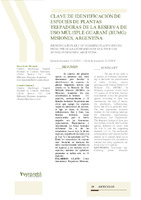Clave de identificación de especies de plantas trepadoras de la reserva de uso múltiple guaraní (rumg) Misiones, Argentina
Identification key of climbing plants species from the guaraní reserve of multiple use (rumg) in Misiones, Argentina
| dc.rights.license | Licencia de Creative Commons Reconocimiento-NoComercial-CompartirIgual 4.0 Internacional (CC BY-NC-SA 4.0) | |
| dc.creator | Miranda, Dora Ester | |
| dc.creator | Dummel, Claudio Javier | |
| dc.date.accessioned | 2020-10-26T17:46:32Z | |
| dc.date.available | 2020-10-26T17:46:32Z | |
| dc.date.issued | 2016-12-01 | |
| dc.identifier.citation | Miranda, D. E., y Dummel, C. J. (2016). Clave de identificación de especies de plantas trepadoras de la reserva de uso múltiple guaraní (rumg) Misiones, Argentina. Yvyraretá: Revista Forestal País de Árboles. Eldorado (Misiones): UNaM. FCF; (23), pp. 50-72. | es_AR |
| dc.identifier.issn | 2469-004X | |
| dc.identifier.other | Yvy-042 | |
| dc.identifier.uri | https://hdl.handle.net/20.500.12219/2676 | |
| dc.identifier.uri | http://www.yvyrareta.com.ar/index.php/component/k2/item/42-clave-de-identificacion | |
| dc.description | Fil: Miranda, Dora Ester. Universidad Nacional de Misiones. Facultad de Ciencias Forestales; Argentina. | es_AR |
| dc.description | Fil: Dummel, Claudio Javier. Universidad Nacional de Misiones. Facultad de Ciencias Forestales; Argentina. | es_AR |
| dc.description.abstract | El objetivo del presente aporte es presentar una clave taxonómica para facilitar la identificación de especies de plantas trepadoras nativas que crecen en la Reserva de Uso Múltiple Guaraní (RUMG) en Misiones, Argentina. En esta contribución se trataron 152 especies, correspondiente a 39 familias botánicas. Se presenta una clave que agrupa las especies según sus mecanismos de ascenso, el tipo de hojas, la filotaxis, inflorescencia, flor y fruto. Las familias botánicas mejor representadas para el hábito trepador son las Asteraceae, Apocynaceae, Bignoniaceae y Sapindaceae. La forma biológica dominante fue el de las enredaderas con el 44,6 % de las especies, seguidas de las lianas con el 31,6 % y las apoyantes 23,7 %. Entre los mecanismos de ascenso más frecuente se destacan los tallos exclusivamente volubles en 69 especies y los zarcillos en 42 especies, mientras los apéndices punzantes se hallan solo en 13 especies. | es_AR |
| dc.description.abstract | The aim of this work is to present an elaborate taxonomic key to facilitate the identification of native climbers´ species growing in the Guarani Reserve of Multiple Use (RUMG) in Misiones, Argentina. In this work 152 species of 39 botanic families were studied. A key that group the species according to their rise mechanisms, the type of leaves, the phyllotaxis, inflorescense, flower and fruit is presented here. The best represented botanical families for the climbing habit are the Asteraceae, Apocynaceae, Bignoniaceae and Sapindaceae. The dominant biological form was the climbers with the 44,6% of the species, followed by lianas with the 31,6 % and the supporting climbers 23,7 %. The exclusively twining stems in 69 species and the tendrils in 42 species stand out as the most frequent rise mechanisms whereas the sharp appendices are found only in 13 species. | en |
| dc.format | application/pdf | |
| dc.language.iso | spa | es_AR |
| dc.publisher | Universidad Nacional de Misiones. Facultad de Ciencias Forestales. Secretaría de Ciencia, Técnica y Posgrado | es_AR |
| dc.rights.uri | http://creativecommons.org/licenses/by-nc-sa/4.0/ | |
| dc.source | Yvyraretá: Revista Forestal País de Árboles, 12-2016; (23): pp. 50-72 http://yvyrareta.com.ar/index.php | |
| dc.subject | Clave taxonómica | es_AR |
| dc.subject | Trepadoras | es_AR |
| dc.subject | Misiones | es_AR |
| dc.subject | Climbing plants | en |
| dc.subject | Taxonomic key | en |
| dc.title | Clave de identificación de especies de plantas trepadoras de la reserva de uso múltiple guaraní (rumg) Misiones, Argentina | es_AR |
| dc.title | Identification key of climbing plants species from the guaraní reserve of multiple use (rumg) in Misiones, Argentina | en |
| dc.type | info:eu-repo/semantics/article | |
| dc.type | info:ar-repo/semantics/artículo | |
| dc.type | info:eu-repo/semantics/publishedVersion |
Files in this item
This item appears in the following Collection(s)
-
Revista Yvyraretá [360]




